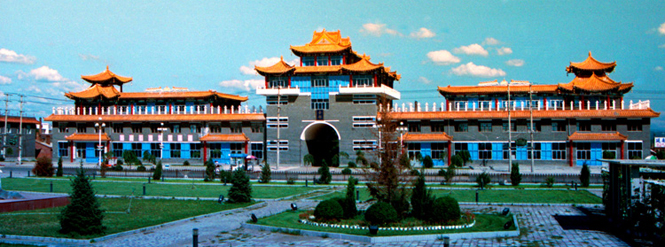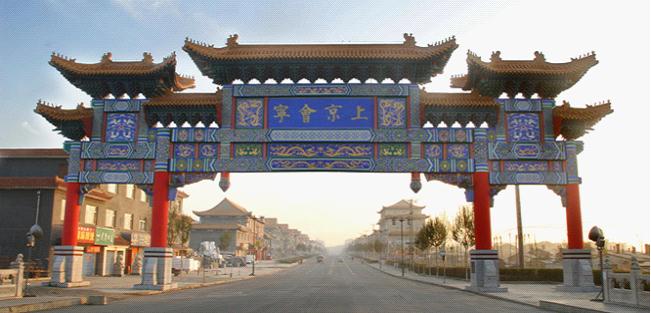 |
|
| Welcome to the A Cheng District of Harbin City People's Government |

¡¡¡¡Acheng is a well-know historic city with rich cultural heritage. Since the late old stone age, which is about 10000 years away from now, people have begun to work, live and multiply in today¡¯s Ashi River Basin. In the Pre-Qin period, Ashi River Basin was where Sushen nationality lived and moved. From the mid-Western Han Dynasty to the W & E Jin Dynasty, Sushen was renamed Louyi, belonging to the State of Fuyu. In the 17th year of Taihe¡¯s reign of the North Wei Dynasty, Fuyu people were driven away by Wuji people. Ashi River Basin was the central area where Wuji people of Anjugu Tribe lived and moved.
¡¡¡¡In the mid -Tang Dynasty, Ashi River Basin became the boundary of the Bohai Kingdom, which was ruined by Qidan people. From the rise of Qidan Nationality to the establishment of the Liao Dynasty, most part of each nationality in Heilongjiang were occupied by the Liao Dynasty, split-up phenomenon occurred in each nationality during the riots, which contributed to the emergence of Jurchen Nationality. In the fifth year of Emperor Tianzuo Yelv Yanxi¡¯s reign of the Liao Dynasty, Aguda become emperor of the Jin Dynasty, with capital Huining (about 4 miles south of today¡¯s Acheng City) established.
¡¡¡¡The Jin Dynasty was ruled by a total of 9 emperors for a total of 120 years. The territory map (the light yellow area on the map is the territory of the Jin Dynasty) of the Jin Dynasty in its period of great prosperity shows that the Jin Dynasty had its territory bordering the sea of Japan and Sakhalin Island (today¡¯s Okhotsk Sea of Russia) respectively on the northeast, bordering Stanovoy Range (today¡¯s Far East Region of Russia) on the north, bordering Mongolia on the northwest, bordering Hetao, Hengshan (Shaanxi), east of Gansu and Xixia respectively on the west, reaching the Qinling Mountain and the Huaihe River in the south, facing the South Song Dynasty, with a population of more than 44.7 million. Although the culture of the Jin dynasty retained and absorbed some cultural traditions of Jurchen nationality, it basically inherited the culture of Han Nationality in the Liao and Song Dynasties. In the 2nd year of Tianxing¡¯ reign of the Jin Dynasty (in 1234), the Jin Dynasty was ruined by the joint attack of Mongolian army and the army of the Song Dynasty.

¡¡¡¡Acheng has long been known as the ¡°Birthplace of Jurchen, No. One Capital of Jin Dynasty¡±. Huining, capital of the Jin Dynasty, was a capital city in the early Jin Dynasty. It was first a state, elevated to a prefecture in the Taizong period, renamed Shangjing in the Xizong period, with Huining County, Qujiang County and Yichun County under its jurisdiction. In 1115, Wanyan Aguda, a great Jurchen leader, founded the Jin Dynasty by the Ashihe River. Jinshangjing Huining Prefecture, where four emperors, Emperor Taizu, Emperor Taizong, Emperor Xizong and Emperor Hailing, ruled for 38 years successively, which was an important stage in the historical development course of Acheng. In the first year of Zhenyuan¡¯s reign (in 1153), the Jin Dynasty relocated in Yanjing (today¡¯s Beijing), making Yanjing its new capital, creating a record of Beijing being used as the capital city of Chinese past dynasties. In the reign of Emperor Yuanshun, the old site of Jinshangjing Huining Prefecture was Zhenning State. In the late Ming Dynasty, the area around the old site of Jinshangjing Huining Prefecture was where a branch of Dong¡¯e Tribe of Jurchen Nationalities lived. In the early Qing Dynasty, the old site of Jinshangjing Huining Prefecture was called Weng¡¯eluo City. In the first year of Shunzhi¡¯ reign, the Qing Dynasty relocated in Beijing, making Beijing its capital, in order to resist outside invasion and strengthen the development and control of its northeastern part. In the 7th year of Yongzheng¡¯s reign, defense general¡¯s yamen moved to a new city, today¡¯s Acheng, which was called Alechuka then.
¡¡¡¡In the a century-long deputy general¡¯s yamen period in Alechuka, due to the important geological location and unique natural conditions of Alechuka, gradual increase of migrants from inside Shanhaiguan, and joint efforts of Han Nationality, Man Nationality and other nationalities, Alechuka witnessed rapid development in such undertakings as economy, culture and education and played a very important role in promoting national unity, fight against the invasion of Russian Empire, reclaiming and opening up wasteland and reinforcing frontier, which was another important stage of historical development before Acheng¡¯s control and after Jinshangjing Huining Prefecture of the Jin Dynasty. In the first year of Xuantong¡¯s reign, the deputy general¡¯s yamen was removed and Acheng County was founded, with Alechuka City briefly referred to as Acheng. In 1932, Acheng was occupied by the Japanese imperialists. In 1945, after the victory of the Anti-Japanese War, Acheng County Democratic Government was established on October 27, 1945. On January 5, 1948, Acheng County Democratic Government was renamed Acheng County Government.
¡¡¡¡In February 1987, approved by the State Council, Acheng County was replaced by Acheng City, under the escrow of Harbin, capital city of Heilongjiang Province. In August 2006, approved by the State Council, Acheng City became an administrative district of Harbin, extending Harbin¡¯s historical context by nearly a thousand years. In the territory of Acheng, a total of 282 immovable cultural relics, including the cultural relics of the Jin Dynasty, have been discovered, including two cultural relic sites under state-level protection (Historical Site of Jinshangjing Huining Prefecture and Yagou Moya Stone Carving). In 2012, the Historical Site of Jinshangjing Huining Prefecture was included in the Standby List of China¡¯s World Cultural Heritages. Acheng has sorted out 55 intangible cultural heritage protection projects, including 44 provincial and municipal-level protection projects and has been appraised as the National Advanced Cultural County, Heilongjiang¡¯s Well-Known Historic and Cultural City and Home of Chinese Engraving Art, forming its unique historic and cultural advantages.

Organizer: Harbin A Cheng District People's Government Office filing number: Black ICP 05002590
Address: Harbin City District of A Cheng Beijing Road No. 66 site
telephone: 53721153 e-mail: acqzfb@163.com postal code: 150300
